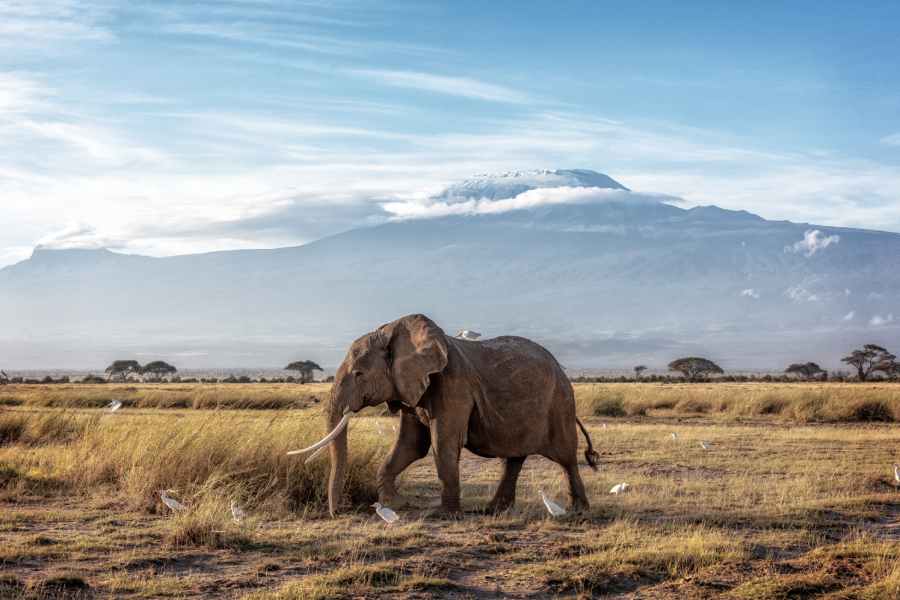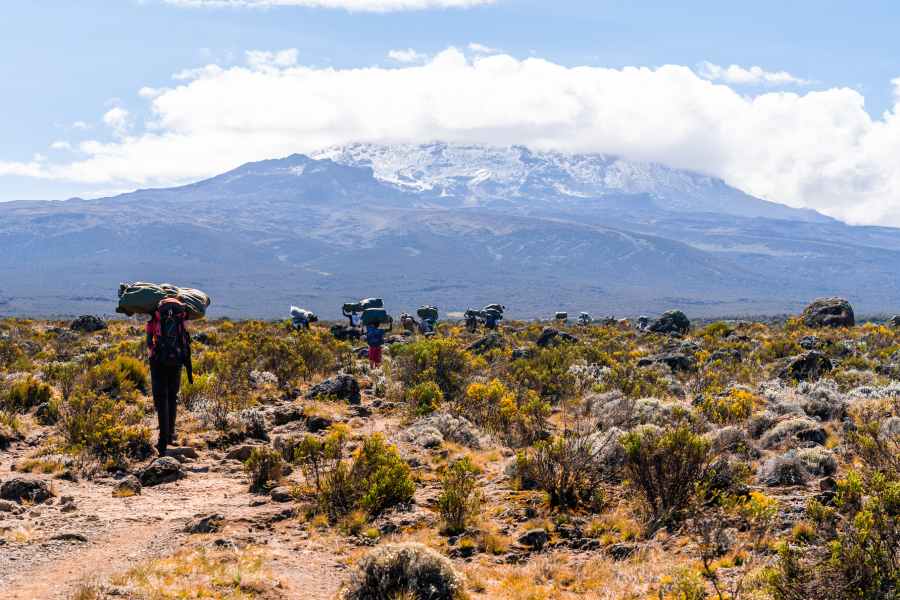Awesome Vacation Adventures In Kilimanjaro National Park
Download Travel Details >PRIVATE & SMALL GROUP TOURS TO THE WORLD'S BEST DESTINATIONS
Join Us For A Safari In Tanzania

Travel Tips For Visiting Kilimanjaro National Park
Nestled in the heart of East Africa, Tanzania is home to the vast Serengeti and the Great Migration, as well as the breathtaking Ngorongoro Crater and Kilimanjaro National Park. If you’re looking to combine an epic wildlife safari with a bucket list trek up Mount Kilimanjaro’s slopes, Tanzania is the place for you! Keep reading to learn more about this incredible vacation package as well as Kilimanjaro tips for an incredible climb.

The Best Time To Trek Kilimanjaro
Kilimanjaro’s prime location near the equator makes it an ideal location to hike nearly year-round. But even with a temperate climate, there are a few rainy seasons to avoid, mainly from March to May and November to December. During this time, the trail conditions tend to be slippery, but still passable - even for a novice hiker. But if you want to see more of Tanzania during your trip, time your Kilimanjaro travel for the country’s long dry season, which falls from July to September. This is a great time to hike Kilimanjaro and go on safari in one of Tanzania’s many national parks.
Can I Go On A Kilimanjaro National Park Safari?
Many people want to summit Mount Kilimanjaro and go on an epic African safari during their trip to Tanzania. But Kilimanjaro National Park is not the best place in Tanzania for a safari. The good news, however, is that Arusha National Park is nearby and can provide adventure seekers with an epic wildlife viewing experience. Alternatively, safari-goers can cross the country after their mountain trek and travel to the Serengeti for a once-in-a-lifetime wildlife viewing experience.
15 Days For An Adventure Of A Lifetime!
 If you can spend 15 days in Tanzania, you will have enough time to experience two of Africa’s most famous natural wonders. From the imposing peaks of Mount Kilimanjaro to the vast plains of the Serengeti, this trip itinerary is designed for those with a passion for the outdoors. The trip begins with an epic trek in Kilimanjaro National Park, followed by game drives across the Serengeti. Highlights of the trip include:
If you can spend 15 days in Tanzania, you will have enough time to experience two of Africa’s most famous natural wonders. From the imposing peaks of Mount Kilimanjaro to the vast plains of the Serengeti, this trip itinerary is designed for those with a passion for the outdoors. The trip begins with an epic trek in Kilimanjaro National Park, followed by game drives across the Serengeti. Highlights of the trip include:
- Trek the Marangu Route up the sides of Kili toward her lofty summit. This trip includes an extra acclimatization day at to increase your chances of completing the summit attempt.
- Hike Mount Kilimanjaro's climactic last stretch by lamplight and give yourself as much chance as possible to watch a sunrise over ice fields from behind Africa’s highest peak.
- Camp along the route in huts (not tents) and carry less gear along the way.
- After your time on Kili, explore the Serengeti National Park in depth with four game drives – two in the early morning and two in the late afternoon.
- Take a mind-blowing safari across the floor of the Ngorongoro Crater in an open-roof vehicle on the hunt for endangered black rhinoceros.
- Camp in the park for a truly magical experience close to nature!
- Visit remote communities for a truly unique opportunity to learn about the local culture.
Kilimanjaro Tips For A Successful Summit
Planning for a safari is much easier than planning a trek up Mount Kilimanjaro! On a safari, you will most likely ride in an overland vehicle driven by a guide to look for wildlife throughout Tanzania’s national parks. However, if you plan to visit Kilimanjaro National Park to summit Mount Kilimanjaro, you will need to plan – and pack! – accordingly.
There are two main tips to make your summit attempt successful. They are: getting in shape and acclimatizing to altitude.
- The first Kilimanjaro tip is to get in shape. It’s imperative to be physically fit to climb Kilimanjaro. To prepare for the journey, spend at least a few months leading up to your adventure doing cardio training like walking and running hills and biking long distances on high resistance to condition your body for the journey ahead.
- The second Kilimanjaro tip is to acclimate to altitude. Ask your doctor about any medications that may assist with your climb and increase ease of altitude acclimatization on the mountain, and which can minimize unwanted symptoms like nausea and headaches. Most tours build in extra days to acclimatize but if you’re new to altitude, selecting a longer climb will increase your body’s ability to successfully adjust to high-altitude conditions.
Navigating Kilimanjaro’s Five Ecological Zones
Kilimanjaro National Park is so vast that you will experience five distinct climate zones with temperature changes during your climb. This can make packing tricky, so defer to your guide’s recommendations! No matter what route you choose, you’ll pass through these five ecological climates on the way to the summit at Uhuru Peak.
- Bushland Zone – this zone sits at 2,600 to 6,000 feet altitude and is situated on the open grasslands surrounding Kilimanjaro. This region typically receives large amounts of rainfall. Coffee and banana plantations can be found in this zone.
- Rainforest Zone – this zone sits at 6,000 to 9,200 feet altitude. It is warm, humid, and lush. All Kilimanjaro climbs begin in this region. This biodiverse section of the mountain is home to many animals, including blue and colobus monkeys, as well as leopards, elephants, rhinoceroses, giraffes, and buffalo.
- Heath and Moorland Zone – this zone sits at 9,2000 to 13,200 feet altitude. As your climb continues, the landscape becomes sparser and much drier. This zone is full of trees draped in bearded lichen and is where you will ascend above the cloud line. The heath and moorland zone is not home to many animals, but you will see a variety of birds during your climb.
- Alpine Desert Zone – this zone sits at 13,200 to 116,500 feet and is rocky and windswept, similar to the surface of the moon. This zone is where many people will experience altitude sickness. Climbers will rest here for a few hours before starting their midnight ascent to Kili’s summit.
- Arctic Zone – this zone sits at 16,500 feet and above! As you enter it, Kilimanjaro’s terrain transforms. Loose scree and gravel make the going tough, and ice and snow begin to collect the higher you go. Once you reach the summit, large ice fields, glittering glaciers, and the upper regions of the neighboring Mawenzi cone are visible.
If your trip to Tanzania includes Kilimanjaro travel and a drive across the Serengeti’s hot spots, you can be assured that you are going to have an adventure of a lifetime! From Kilimanjaro National Park to top safari locations in Tanzania’s northern region, adventure awaits. Experience the best of both worlds on a package trip that offers adventure with every step.

